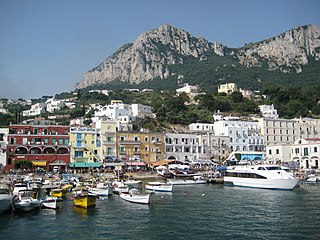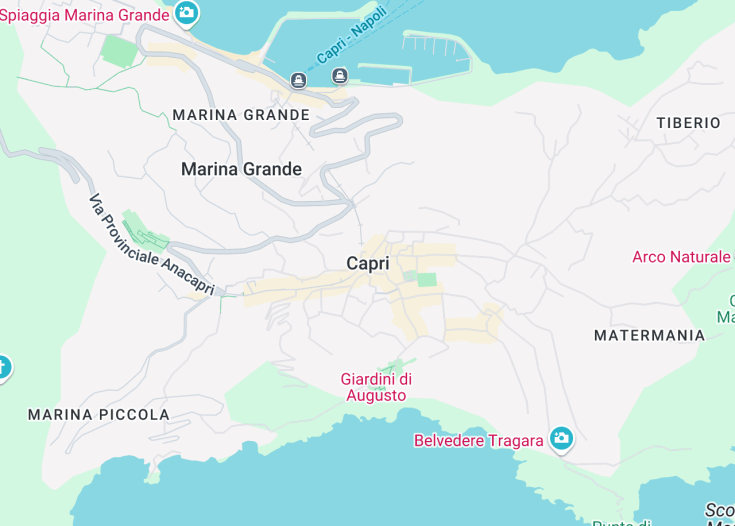Capri, an enchanting island in Italy’s Bay of Naples, is famed for its rugged landscape, upscale hotels, and shopping, from designer fashions to limoncello and handmade leather sandals. The island’s history is rich with tales of Roman rulers and famous artists finding solace and inspiration among its verdant hills and terracotta rooftops. The Blue Grotto, with its stunning sea views, continues to draw visitors from across the globe.
When visiting Capri, be sure to experience the chairlift ride to Monte Solaro. The breathtaking panoramic views from the summit are worth the ascent and offer unforgettable photo opportunities.
A must-do is a boat tour around the island; it’s an excellent way to appreciate Capri’s dramatic coastline, including the mesmerizing Faraglioni rocks.
Top things to do & see in Capri
Select the following sights and activities to discover best tickets and tours available in Capri.
Capri: An Italian Gem in the Heart of the Mediterranean
| Country | Italy |
| Time in Capri | GMT+1 |
| Language spoken | Italian |
| Population | 7,278 (As of 2021, according to ISTAT) |
| Currency | Euro (€, EUR) |
| Airports |
|
Capri, an island located in the Tyrrhenian Sea off the Sorrentine Peninsula, is a captivating destination renowned for its rugged landscape, upscale hotels, and shopping, from designer fashions to limoncello and handmade leather sandals. Its history is rich with tales of literary and artistic figures who sought inspiration in its idyllic surroundings.
The island’s topography is varied and dramatic, with cliffs that vertically jump from the sea bed elegantly crowned by luxuriant vegetation. Sightseeing is most notable in sites such as the Blue Grotto (Grotta Azzurra), the Marina Piccola (the little harbor), the Belvedere of Tragara (a high panoramic promenade lined with villas), the limestone crags called sea stacks that project above the sea (Faraglioni), and the town of Anacapri, where Villa San Michele provides views of the city of Capri and its harbor, the Sorrentine Peninsula, and Mount Vesuvius.
The captivating allure of Capri extends to its ancient archaeological sites. Remains of imperial Roman villas build a picturesque narrative of Capri’s past under the Romans. The famous Villa Jovis, the largest of the twelve villas built by Emperor Tiberius on the island, remains a potent draw for visitors worldwide. Moreover, the medieval San Michele Church, with its intricately decorated floors depicting the expulsion from the Garden of Eden, offers a unique view into the theological artistry of northern Italian craftsmen.
Capri’s natural beauty complements its cultural and historical significance, making it a timeless retreat for artists, writers, celebrities, and travelers seeking solace away from their bustling lives. Each winding path and secluded cove tells a story, each sunset on the horizon a reminder of the island’s enchanting vitality and charm.
Where is Capri?
Located in the Campania region of Italy, Capri is a picturesque island in the Bay of Naples, just south of the city of Naples.
Distances:
| Route | Distance by car | Time |
|---|---|---|
| Naples to Naples Ferry Terminal | 4.8 mi | 30 min |
| Ferry to Capri | 20.2 mi (By sea) | Approx. 1 hour 20 minutes (Ferry) |
What is Capri famous for?
Capri is famous for its stunning panoramas, upscale hotels, posh lifestyle, and blue waters speckled with exclusive beach resorts and Roman historical ruins. The island is a blending image of natural beauty, art, and history.
History
Prehistoric to Roman Era (Prehistory – 27 BC)
Capri has a long and storied past, tracing back to the prehistoric times when it was first inhabited by Neolithic communities. The island, celebrated for its breathtaking beauty, caught the attention of the Greeks in the 8th century BC, subsequently followed by the Romans. It was during the Roman domination that Capri began to gain prominence, particularly when Emperor Augustus discovered its beauty and made it his preferred retreat, acquiring it from the city of Naples in exchange for Ischia. This marked the beginning of Capri’s transformation, with significant construction including villas and aqueducts.
Medieval to Early Modern Period (28 AD – 1700 AD)
Following the fall of the Roman Empire, Capri saw periods of neglect and resurgence in interest. Throughout the medieval era, the island was frequently raided by pirates, leading to periods of desolation. However, in the 13th century, Capri was revitalized under the rule of Naples. Monastic orders established their presence, constructing churches and monasteries. The island oscillated under different authorities, which helped shape its diverse cultural character, imbuing it with a blend of Italian and foreign influences that is still apparent today.
Modern Era (1701 – Present)
In the 19th century, Capri became a magnet for international artists, writers, and intellectuals, attracted to its idyllic scenery and tranquil lifestyle. This cultural resurgence dubbed Capri a glamorous escape, leading it to become a favored destination among the European jet set and a popular tourist spot. Today, Capri continues to allure visitors from around the globe, maintaining its status as a timeless and luxurious retreat, enriched by its extensive, multifaceted history.
Visit Capri
What to see and do in Capri, Italy
Exploring Capri is a journey through breathtaking scenery and cultural landmarks. Begin at the legendary Blue Grotto, a sea cave where the water glows an ethereal blue. Venture up to Anacapri, a quieter village with stunning views and the Villa San Michele featuring beautiful gardens and art. Don’t miss the Monte Solaro chairlift for panoramic vistas. Stroll through Capri town’s bustling Piazzetta for upscale shopping and dining, and hike the Phoenician Steps for a glimpse of ancient pathways. For the historically inclined, the ruins of Emperor Tiberius’ Villa Jovis offer insights into Roman history surrounded by scenic splendor.
Festive Capri
Capri hosts several vibrant events year-round, attracting visitors with its eclectic mixtures of cultural and traditional experiences. Notable events include the Capri Hollywood Film Festival held in December, celebrating international cinema amid island vistas. Summer brings the Festival of San Costanzo—Capri’s patron saint—in May with parades and fireworks, and the International Folklore Festival in August, showcasing traditional music and dance that highlight the island’s rich cultural tapestry.
Best time to visit Capri
The ideal time to visit Capri is between April and October when the weather is most pleasant, allowing for all activities from sightseeing to relaxing on its iconic pebbled beaches. The peak tourist season is July and August; visiting in the shoulder months (April, May, September, October) provides a more relaxed experience with fewer crowds and mild temperatures.
Is Capri worth visiting?
Capri offers a blend of natural beauty, historical depth, and modern luxury, appealing to a wide variety of travelers. Its landscapes are stunning, from dramatic cliffs to lush gardens, and the cultural heritage is rich with ancient and modern influences. However, it can be crowded, especially in peak summer months, and may be considered pricey. Yet, the uniqueness of its settings and the plethora of activities from hiking to haute cuisine dining makes Capri a distinctive destination that many find worth the splurge and the hustle.










